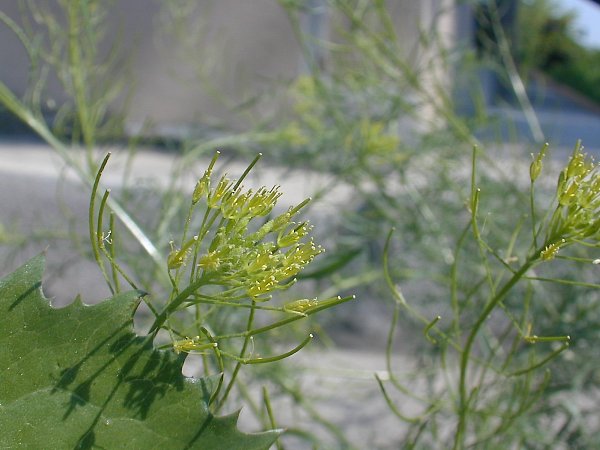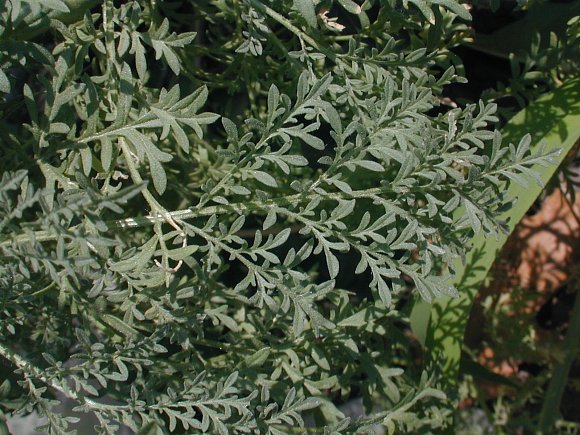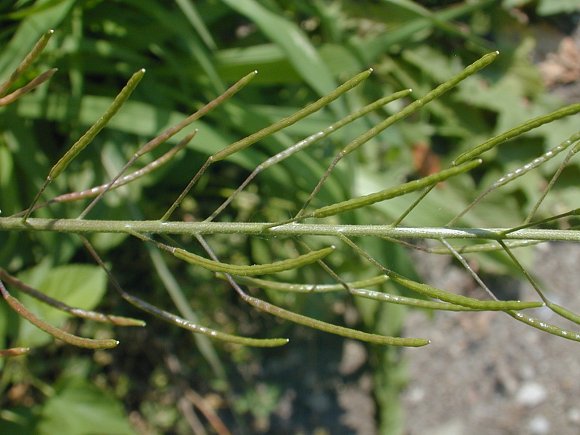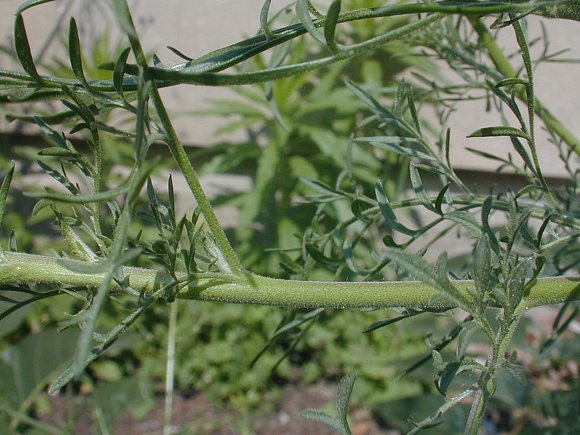Description: This biennial or annual plant is ½–2½' tall. It branches occasionally, and is more or less erect. The stems are greyish or bluish green and pubescent; sometimes the lower stem is nearly glabrous and light purplish green. During the 1st year, biennial plants consist of a low-growing rosette of basal leaves spanning up to 1' across. The cauline leaves of annual and 2nd-year biennial plants alternate along the flowering stems, spanning up to 8" long and 4" across and becoming progressively smaller higher up on the stems. Both the basal and cauline leaves are double or triple pinnately lobed, greyish or bluish green, and finely pubescent. The basal and lower cauline leaves have long petioles, while the petioles of the upper cauline leaves are shorter.

The upper stems terminate in racemes of flowers about 2-12" in length. The flowers bloom near the apex of each raceme, while the siliques (slender seedpods) develop below. Each small flower is about 1/8" across, consisting 4 pale yellow petals, 4 green sepals, 6 stamens with yellow anthers, and a pistil with a single style. Both the sepals and petals are quite narrow (especially the latter); the petals are about the same length as the sepals or a little shorter. The blooming period occurs from late spring to mid-summer and lasts about 2 months. There is no noticeable floral scent. Each flower is replaced by a silique about 1" in length. This silique is narrowly cylindrical (about 1 mm. in diameter) and its contains 10-20 tiny seeds in a single row. The slender pedicels of the siliques (or flowers) are about ½" in length. The siliques and their pedicels are spreading-ascending in relation to the stalk of the raceme. Each tiny seed is somewhat flattened and oblongoid; it is some shade of orange-brown. The root system consists of a stout taproot. This plant spreads by reseeding itself; the seeds are small enough to be blown about by the wind.

Cultivation:
Flixweed
flourishes in full sun, mesic to dry conditions, and almost any kind of
soil. It is taller and more robust on fertile loam, and much smaller in
size on dry sterile soil containing gravel or sand. During hot dry
weather, the lower leaves may wither away.
Range & Habitat:
The non-native Flixweed is an uncommon plant that occurs primarily in
NE and west
central Illinois; it is rare or absent elsewhere (see Distribution
Map). However, it is probably spreading into other areas of
the state. Habitats include gravelly or sandy areas along railroads and
roadsides, barnyards and pastures, construction sites, and
miscellaneous waste areas that are sunny and dry. Flixweed is native to
Eurasia; it prefers disturbed areas.

Faunal Associations: The nectar and pollen of the flowers attract flower flies and possibly other insects. The caterpillars of the butterflies Pieris rapae (Cabbage White), Pontia protodice (Checkered White), and Anthocharis midea (Falcate Orangetip) feed on the foliage. The relationship of Descurainia spp. (Tansy Mustards) to birds and mammalian herbivores is poorly understood in the eastern states, although in the western states the seedpods are eaten by various species of quail and the foliage is eaten sparingly by Bighorn sheep, elk, and mule deer. However, all parts of the plant have been found to be somewhat toxic to livestock, especially horses and cattle (sheep and goats are more tolerant). The tiny seeds become sticky when wet, and may be carried about in the feathers of birds, fur of animals, or shoes of humans.

Photographic
Location:
Near the Urbana Public Library in Urbana, Illinois, in an area that was
subjected to disturbance from construction activities.
Comments:
Flixweed is similar in appearance to Descurainia pinnata
(Tansy Mustard); the latter is native to both the Old World
and New World. The biggest difference between these two species are the
siliques (seedpods): Flixweed has siliques that are more narrow (1 mm.
in diameter) and longer (about 1" in length); its seeds are arranged in
a single row. Tansy Mustard has siliques that are broader (1.5 mm. in
diameter) and shorter (about 1/3" in length); its seeds are arranged in
two rows.